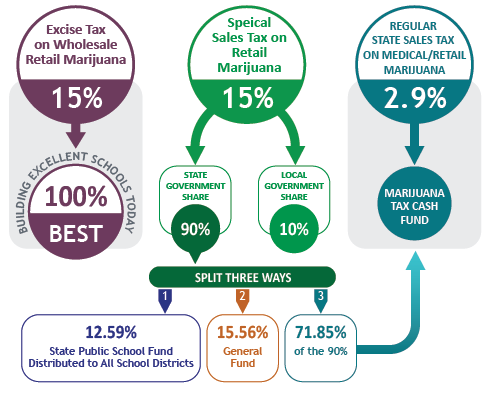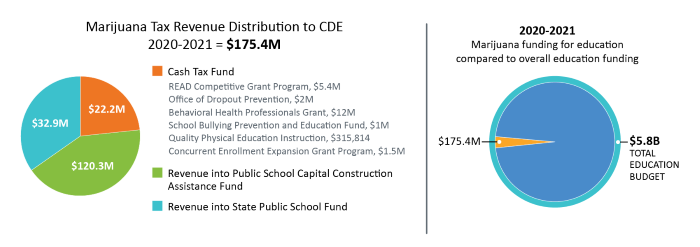We need your feedback to help improve the CDE website.
Please take a few moments to fill out the CDE Website Effectiveness and Usability Survey by Sept. 23.
Let us know how you and your audience use the website and how we can make that experience better.
You are here
Marijuana Tax Revenue and Education
Overview
In 2012, Colorado voters approved the legal sale of marijuana to adults 21 and older with a portion of the tax revenue going to education. Though the amount of tax revenue that comes from marijuana sales is minimal -- around 1% of the state's total education budget -- the money is directed to a variety of programs, including school construction, bullying prevention and behavioral health. This is a brief glimpse of the revenue that comes into the Colorado Department of Education through marijuana sales.
Legislation
In 2012, Colorado voters approved Amendment 64 which allowed adults 21 and older to consume or possess marijuana and required the state to set up a regulatory structure for the retail marijuana industry. It also mandated an excise tax with the first $40 million collected to be reserved for school construction.
In 2013, voters approved Proposition AA, allowing the state to levy up to a 15% excise tax on unprocessed marijuana and up to a 15% retail tax on marijuana sales. In addition, both medical and retail marijuana continue to be subject to the state’s 2.9% sales tax.
In 2017, Senate Bill 267, changed the formula, increasing the statewide retail tax to 15% from 10% and changing how the revenue was distributed.
In 2018, the legislature passed House Bill 1070, changing the formula for the amount of excise tax on retail marijuana that can be collected. Starting July 1, 2018, the excise tax collected for education was either greater than 90% of the revenue annually collected or the first $40 million collected.
But that again changed in 2019 when House Bill 1055 mandated that 100% of excise tax on retail marijuana must be collected for school construction.
How is marijuana tax revenue distributed?
- Excise tax: One hundred percent of marijuana excise tax revenue collected is credited to the state’s Capital Construction Assistance Fund, which funds the Building Excellent Schools Today (BEST) program.
- Sales tax: Ten percent of the state's 15% state marijuana retail tax revenue is allocated to local governments and distributed according to the percentage of marijuana sales within the city and/or county boundaries.
- Here's how the remaining 90% of the retail tax revenue is apportioned:
- 15.56% will stay in the General Fund
- 71.85% will be credited to the MTCF
- 12.59% will be credited to the state public school fund and distributed to all districts
- Here's how the remaining 90% of the retail tax revenue is apportioned:
Building Excellent Schools Today (BEST)
Written into Amendment 64 is a commitment to credit the Colorado Capital Construction Assistance Fund with the first $40 million generated each fiscal year from the retail marijuana excise tax to renovate existing school buildings or construct new buildings. In 2018, the state legislature passed House Bill 1070, increasing the amount of retail marijuana excise tax that can be credited to the assistance fund. In 2019, the legislature changed the fund to allow 100% of the excise tax collected to go to the Capital Construction Assistance Fund.
The BEST program prioritizes health, safety and security issues such as asbestos removal, new roofs, building code violations, and poor indoor air quality. BEST grants are competitive, awarded annually and in most cases must be supplemented with local district matching funds.
A statewide facility assessment completed in 2009 inventoried more than 8,000 facilities and more than 123 million square feet were assessed, revealing $13.9 billion in capital construction needs. This need has grown every year since.
Marijuana tax revenue is just one of four funding sources for the Capital Construction Assistance Fund, the total of which is only a fraction of what is needed for the repair, maintenance and construction of Colorado’s public schools.
Here is how marijuana excise tax revenue has been used for the Capital Construction Assistance Fund:
- In Fiscal Year 2021-22, $97,344,277 was allocated to the Capital Construction Assistance Fund.
- In Fiscal Year 2020-21, $40 million of marijuana excise tax was allocated to the Capital Construction Assistance Fund with $80.3 million in excess excise tax revenue transferred to the Public School Capital Construction Assistance Fund.
- In Fiscal Year 2019-20, $89.7 million of marijuana excise tax was allocated to the Capital Construction Assistance Fund.
- In Fiscal Year 2018-19, $52.6 million of marijuana excise tax was allocated to the Capital Construction Assistance Fund.
- In Fiscal Year 2017-18, $40 million of marijuana excise tax was allocated to the Capital Construction Assistance Fund.
- In Fiscal Year 2016-17, $40 million of marijuana excise tax was allocated to the Capital Construction Assistance Fund with the excess $5.7 million going to the Public School Fund.
- In Fiscal Year 2015-16, $40 million in marijuana excise tax was allocated to the Capital Construction Assistance Fund that supports the BEST competitive grant program, plus an additional $40 million was paid into the fund from a one-time disbursement resulting from Proposition BB, a successful statewide ballot measure in 2015 that allowed the state to keep the surplus in marijuana tax revenue.
Marijuana Tax Cash Fund (MTCF)
In 2014, the state legislature created the Marijuana Tax Cash Fund to collect sales tax revenue from retail and medical marijuana. Revenue from MTCF must be spent the following year on health care, to monitor the health effects of marijuana, health education, substance abuse prevention and treatment programs and law enforcement.
Under MTCF the department has received money specifically for:
- The School Health Professional Grant program to address behavioral health issues in schools.
- A grant program to help schools and districts set up initiatives to reduce the frequency of bullying incidents.
- Grants to fund drop-out prevention programs.
- Early Literacy Competitive Grants to ensure reading is embedded into K-3 curriculum.
- A grant to expand concurrent enrollment programs.
- Grants to fund physical education courses and social-emotional health programs for K-5 students.
Marijuana tax revenue distributions to the Colorado Department of Education, 2015-2021
School Construction – Capital Construction Assistance Fund
- 2015-16: $80 million*
- 2016-17: $40 million
- 2017-18: $40 million
- 2018-19: $52.6 million
- 2019-20: $89.7 million
- 2020-21: $120.3 million
- 2021-22: $97.3 million
Early Literacy Competitive Grant Program
- 2016-17: $4.4 million
- 2017-18: $4.4 million
- 2018-19: $5.4 million
- 2019-20: $5.4 million
- 2020-21: $5.4 million
- 2021-22: $5.4 million
School Health Professional Grant Program
- 2015-16: $2.3 million
- 2016-17: $2.3 million
- 2017-18: $11.9 million
- 2018-19: $11.9 million
- 2019-20: $11.9 million
- 2020-21: $11.9 million
- 2021-22: $11.9 million
School Bullying Prevention & Education Grant Program
- 2015-16: $2 million
- 2016-17: $900,000
- 2017-18: $2 million
- 2018-19: $2 million
- 2019-20: $2 million
- 2020-21: $1 million
- 2021-22: $1 million
Drop-out Prevention Programs
- 2015-16: $2 million
- 2016-17: $900,000
- 2017-18: $2 million
- 2018-19: $2 million
- 2019-20: $2 million
- 2020-21: $2 million
- 2021-22: $2 million
State Public School Fund
- 2017-18: $30 million
- 2018-19: $20 million
- 2019-20: $25.6 million
- 2020-21: $32.9 million
- 2021-22: Undetermined
Marijuana funding for education compared to overall education funding
2015-16
- Marijuana revenue for CDE: $86.3 million
- Overall state K-12 education funding: $5.3 billion*
2016-17
- Marijuana revenue for CDE: $54.2 million
- Overall state K-12 education funding: $5.4 billion*
2017-18
- Marijuana revenue for CDE: $90.3 million
- Overall state K-12 education funding: $5.6 billion*
2018-19
- Marijuana revenue for CDE: $81.3 million
- Overall state K-12 education funding: $5.7 billion*
2019-20
- Marijuana revenue for CDE: $132.4 million
- Overall state K-12 education funding: $6.7 billion*
2020-21
- Marijuana revenue for CDE: $175.4 million
- Overall state K-12 education funding: $5.8 billion*





Connect With Us




